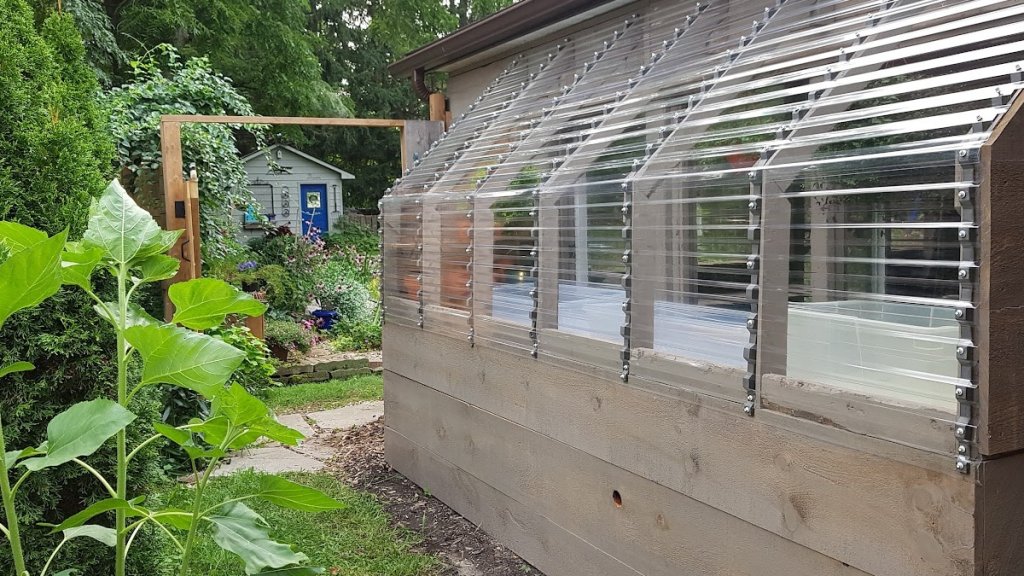“Welcome to the crowning glory of your lean-to greenhouse project—the roof. This piece isn’t just a tutorial on covering your structure; it’s a gateway to understanding how elements like eco-friendly shed heating solutions can enhance your gardening oasis.
As you delve into the world of greenhouse gardening, you’ll soon realize that the roof isn’t just an overhead cover; it’s the guardian of your botanical paradise. In this article, we will uncover the secrets of roofing for lean-to greenhouses, exploring why it’s so crucial, how it impacts your plants’ well-being, and what roofing materials are at your disposal. So, grab your gardening hat, and let’s ascend to new heights of knowledge!
Roofing Materials for Lean-to Greenhouses
When covering your lean-to greenhouse, the choice of roofing material can significantly influence its performance and the overall gardening experience. Let’s take a closer look at the options available:
Polycarbonate Panels
Polycarbonate panels are the superstars of greenhouse roofing materials, making them a top choice for gardeners looking to cultivate various types of flowers for gardening. These panels bring a wealth of benefits to the table:
Benefits of Polycarbonate: Polycarbonate panels offer excellent insulation, diffusing sunlight to create a favorable climate for your plants. They come in different types, such as single-wall, double-wall, and multi-wall, each with varying insulation levels and light diffusion. These panels are incredibly durable and can withstand impacts, hail, and harsh weather conditions.
Types of Polycarbonate Panels: This section will explore the different types of panels available, helping you make an informed choice for your lean-to greenhouse. Whether you prioritize insulation, light diffusion, or budget-friendliness, you have a polycarbonate panel.
Glass Roofs
Glass roofs exude a classic charm, making them ideal for showcasing the world’s top flowers with their unique set of advantages, though they also come with considerations:
Advantages of Glass: Glass roofs provide exceptional clarity, allowing maximum sunlight penetration. They create a visually appealing and aesthetically pleasing environment. Glass is incredibly durable and can last decades if maintained properly.
Drawbacks: However, glass roofs can be heavy, requiring robust structural support. They may pose safety concerns due to breakage. Insulation can be a challenge, as glass tends to conduct heat. Regular cleaning and maintenance are also essential to keep the glass clear and free from algae or mineral deposits.
Polyethylene Film
If you’re looking for an affordable and versatile roofing material, polyethylene film might be your answer:
Affordability and Versatility: Polyethylene film is a cost-effective option for lean-to-green roofs. It allows diffused light to reach your plants while keeping costs low. It’s easy to install and replace, making it a practical choice for DIY enthusiasts.
Lifespan and UV Resistance: Learn about the lifespan of polyethylene film and how it fares in terms of UV resistance. Discover tips for installation and maintenance to ensure your greenhouse remains snug under its plastic canopy.
Shade Cloth and Netting
Your lean-to greenhouse might sometimes need a little relief from the scorching sun. Shade cloth and netting come to the rescue:
Providing Shade: Explore the role of shade cloth and netting in creating a shaded environment for your plants. Discover how these materials can reduce heat stress during the year’s hottest months.
Strategic Usage: Learn when and how to deploy shade cloth and netting to balance sunlight exposure for your plants. It’s all about finding the sweet spot between shade and sunlight.
With this knowledge, you can decide on the roofing material that best suits your lean-to greenhouse. But roofing is not just about the material but also design, ventilation, and installation. In the upcoming sections, we’ll delve deeper into the art and science of roofing your greenhouse. So, keep reading and let your greenhouse dreams reach for the sky!

